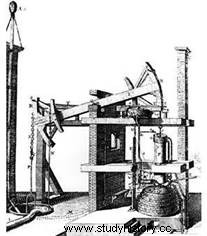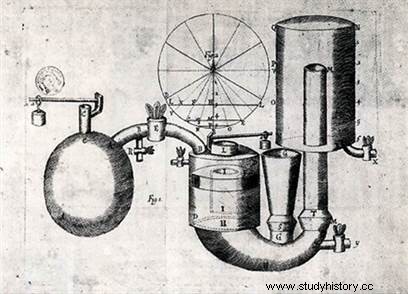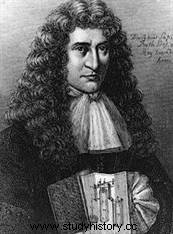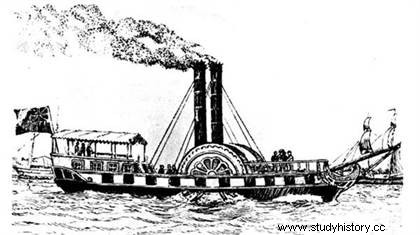 The Invention of the Steam Engine , is the story of a long process of discovery that began in antiquity. In 1679, the Frenchman Denis Papin designs a kind of Steam pressure cooker to study gas pressure. In 1712, Thomas Newcomen develops the first steam engine , which is used to pump water from the Dudley coal mine , in England. English James Watt will be at the origin of another great innovation:the use of pressurized steam, which will considerably improve the operation of the machine. Watt's patents fell into the public domain, many builders improved performance and workmanship. Although it was not its origin, the steam engine contributed greatly to the industrial revolution of the 19th century.
The Invention of the Steam Engine , is the story of a long process of discovery that began in antiquity. In 1679, the Frenchman Denis Papin designs a kind of Steam pressure cooker to study gas pressure. In 1712, Thomas Newcomen develops the first steam engine , which is used to pump water from the Dudley coal mine , in England. English James Watt will be at the origin of another great innovation:the use of pressurized steam, which will considerably improve the operation of the machine. Watt's patents fell into the public domain, many builders improved performance and workmanship. Although it was not its origin, the steam engine contributed greatly to the industrial revolution of the 19th century.
Using steam to produce mechanical energy
 The principle of the steam engine is the transformation of heat energy from steam into mechanical energy, by expansion and cooling of the vapor in a cylinder equipped with a movable piston. The steam necessary for the production of energy or heat is generally provided by a boiler. The simplest boilers consist of a container containing water, which is heated so as to obtain saturated steam.
The principle of the steam engine is the transformation of heat energy from steam into mechanical energy, by expansion and cooling of the vapor in a cylinder equipped with a movable piston. The steam necessary for the production of energy or heat is generally provided by a boiler. The simplest boilers consist of a container containing water, which is heated so as to obtain saturated steam.
Usual domestic heating systems usually have a boiler of this type, but steam power plants, used for industrial energy production, have a design and equipment more complex auxiliaries. The efficiency of a steam engine is often low, and for this reason steam engines have often been replaced by steam turbines.
Tuning the steam engine
The first research on steam dates back to antiquity. Until then, mechanical production had not been able to make significant progress, because the only driving forces available were the physical energy, always limited, of man or animal. and natural forces such as wind and water, too dependent on geographical and climatic factors. Since ancient times, it has been recognized that the elastic force of steam increases under the effect of temperature. In his Pneumatics, Heron of Alexandria (around the 1st century AD) had described the aeolipyle, a kind of hollow metallic sphere whose rotational movement was caused by the escape of steam in tubes.
 From the early years of the 17th century, people thought of using water vapor as a source of energy industrial (work by Giovanni Battista Délia Porta, 1601; by Salomon de Caus, around 1615; by Edward Somerset, 1663). The work of Torricelli and Guericke in the 17th century focuses on the possibility of condensing steam.
From the early years of the 17th century, people thought of using water vapor as a source of energy industrial (work by Giovanni Battista Délia Porta, 1601; by Salomon de Caus, around 1615; by Edward Somerset, 1663). The work of Torricelli and Guericke in the 17th century focuses on the possibility of condensing steam.
The French physicist Denis Papin exposes, in Description and use of the new machine for raising water , his idea of a machine working with a piston moving in an alternating motion in a cylinder, under the pressure of steam obtained by heating a mass of water. The first piston engine was developed in 1690, and was used for pumping water. Papin's machine, more than a curiosity, is a basic machine operating under atmospheric pressure, the steam therefore not being compressed.
The first practical applications of this research were for steam pumps to evacuate water from coal and copper mines. In 1698, Thomas Savery invented the first pumping machine using steam. Much more ingenious, Thomas Newcomen's machine (1705) set in motion a piston which oscillated a pendulum connected by rods to a pump placed at the bottom of the well.
Introduced in the English mines around 1711-1712, this machine saw many uses for more than half a century (there were about one hundred and sixty examples around 1760). But the principle on which it was based consisted in creating, inside the cylinder, a vacuum in which the piston was pushed by the pressure of the outside air; for this it was necessary to alternately heat and cool the cylinder, which entailed an enormous loss of fuel.
James Watt's improvements
The main constraint of the steam engine lies in the metallurgical techniques necessary for its practical realization and to achieve a reliable and economically viable result. The breakthrough was made by Scottish mechanic James Watt. Called in 1763 to repair a model of Newcomen's machine used for experiments by the University of Glasgow, he noted that, "to avoid any unnecessary condensation, it was necessary that the cylinder where the steam came to act on the piston always remained as hot than the steam itself... To obtain the desired vacuum, the condensation had to take place in a separate container, where the temperature could be lowered as much as necessary, without that of the cylinder being modified» .
So as early as 1765, Watt attached to the machine a separate capacitor from the cylinder. In 1769, he patented his first improvements. But it took him another thirteen years of experimentation before perfecting, in 1782, the double-acting engine, in which the steam was allowed alternately on each side of the piston; this machine was also provided with a device which, by transforming the oscillating movement of the piston into a circular movement, made it capable of all kinds of applications. This invention was only able to gain wide circulation thanks to the team of specialized mechanics created in Soho, near Birmingham, by Watt's partner, Matthew Boulton, whose factory produced some five hundred Watt machines before the end of the 18th century. century.
The slow spread of the steam engine
To see the earliness of the application of the steam engine in mines or cotton mills in England and other European countries - a machine from Newcomen is installed at Schemnitz, in Slovakia, as early as 1722; in Passy, France, from 1726 - does not imply its generalization to the average industrial fabric, even in Great Britain. In British industry, the steam engine was used in the first half of the 19th century, only in the most modern sectors:the cotton industry, metallurgy, mechanical engineering and mining.
Traditional forms of motors - the water or windmill, and horse rides - still prevail. Locomotives are used for agricultural threshing, but are not the rule. Paradoxically, the steam engine will become widespread during the "great depression" of the years 1873 to 1896, when the British economy slows down and loses its lead in productivity.
In France, Germany, Switzerland and the United States, the introduction of the steam engine is slow and late. The water mill remained the dominant industrial engine until the end of the 19th century in regions where the relief gave enough speed to the rivers and where their flow was regular, suffering neither from drought nor from frost. Manufacturers made this choice because it was more economical. The water mill is very expensive to install because it requires the digging of a reach to bring the water, but then its operation costs little. The purchase price of a steam engine is lower, but that of its operation and maintenance is high:in addition to the price of fuel, it is necessary to pay a full-time mechanic and to operate it continuously, because the pressurization time is long.
In countries where the cost of coal is high, steam engines are not widespread, except in large enterprises. Nevertheless, as in the Faubourg Saint-Antoine, in Paris, power rental companies can distribute the energy to artisanal workshops which connect their belts to a rotating axis in the street. In France, it was especially in the 1920s that steam engines became the most widespread industrial engine. In the 1930s, their total power peaked and their number decreased, because above all machines with high unit power remained, such as those of thermal power stations for electricity production.
A driving force still used
The principle and techniques for making a reciprocating engine converted into rotary motion can be found at the end of the 19th century in engines where external combustion was replaced by a internal combustion, gas or oil. Many processes come from steam engines, such as the crankcase, where the crankshaft rotates in oil, or the systems of several star cylinders for aircraft engines.
At the same time, the steam engine was gradually associated with the techniques of continuous motion that engineers, such as Benoît Fourneyron (1802-1867), had advanced during the 19th century. century in hydraulics. Steam turbines appeared in industry and the navy at the beginning of the 20th century, when it was possible to manufacture rotors rotating at very high speeds. Finally, nuclear power plants are external combustion engines using the steam fluid to move turbines.
Bibliography
- History of the Steam Engine, by Robert Henry Thurston. Decoopman, 2014.
- The Steam Engine, by Louis Figuier. CIPP, 2015.

